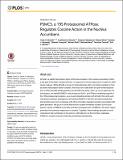PSMC5, a 19S Proteasomal ATPase, Regulates Cocaine Action in the Nucleus Accumbens
Author(s)
Ohnishi, Yoko H.; Ohnishi, Yoshinori N.; Nakamura, Takanori; Ohno, Mizuki; Kennedy, Pamela J.; Yasuyuki, Ohkawa; Nishi, Akinori; Tsuzuki, Teruhisa; Nestler, Eric J.; Neve, Rachael L.; ... Show more Show less
DownloadOhnishi-2015-PSMC5, a 19S Proteas.pdf (2.189Mb)
PUBLISHER_CC
Publisher with Creative Commons License
Creative Commons Attribution
Terms of use
Metadata
Show full item recordAbstract
ΔFosB is a stable transcription factor which accumulates in the nucleus accumbens (NAc), a key part of the brain’s reward circuitry, in response to chronic exposure to cocaine or other drugs of abuse. While ΔFosB is known to heterodimerize with a Jun family member to form an active transcription factor complex, there has not to date been an open-ended exploration of other possible binding partners for ΔFosB in the brain. Here, by use of yeast two-hybrid assays, we identify PSMC5—also known as SUG1, an ATPase-containing subunit of the 19S proteasomal complex—as a novel interacting protein with ΔFosB. We verify such interactions between endogenous ΔFosB and PSMC5 in the NAc and demonstrate that both proteins also form complexes with other chromatin regulatory proteins associated with gene activation. We go on to show that chronic cocaine increases nuclear, but not cytoplasmic, levels of PSMC5 in the NAc and that overexpression of PSMC5 in this brain region promotes the locomotor responses to cocaine. Together, these findings describe a novel mechanism that contributes to the actions of ΔFosB and, for the first time, implicates PSMC5 in cocaine-induced molecular and behavioral plasticity.
Date issued
2015-05Department
Massachusetts Institute of Technology. Department of Brain and Cognitive SciencesJournal
PLOS ONE
Publisher
Public Library of Science
Citation
Ohnishi, Yoko H., Yoshinori N. Ohnishi, Takanori Nakamura, Mizuki Ohno, Pamela J. Kennedy, Ohkawa Yasuyuki, Akinori Nishi, Rachael Neve, Teruhisa Tsuzuki, and Eric J. Nestler. “PSMC5, a 19S Proteasomal ATPase, Regulates Cocaine Action in the Nucleus Accumbens.” Edited by James Edgar McCutcheon. PLOS ONE 10, no. 5 (May 11, 2015): e0126710.
Version: Final published version
ISSN
1932-6203